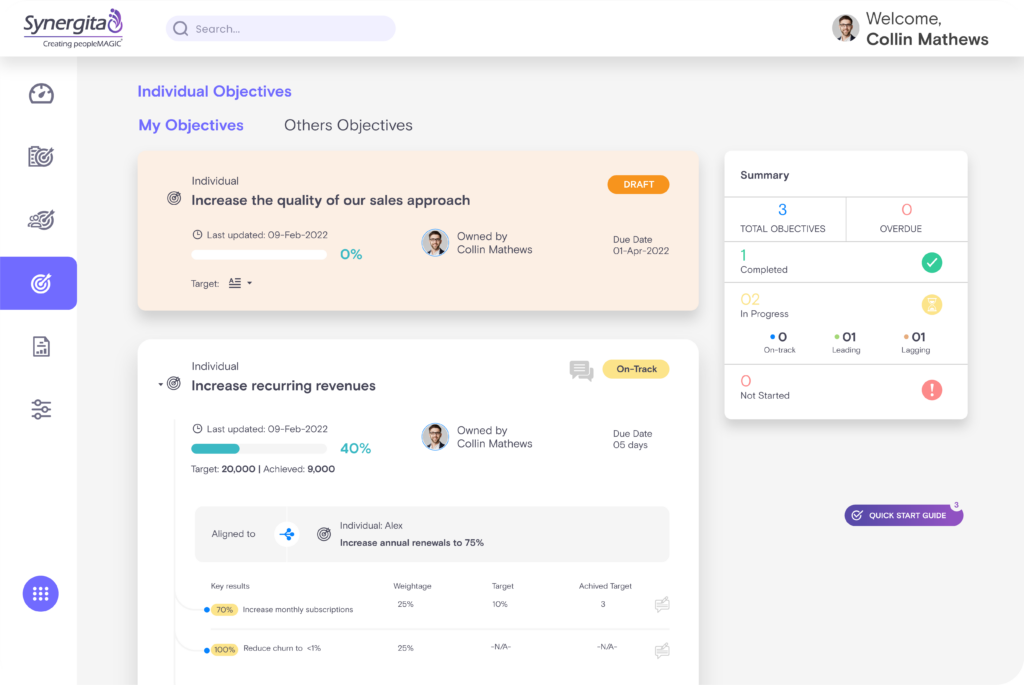How does Synergita help align YOUR OKRs with Organizational Goals?
OKRs (Objectives and Key Results) is a goal-setting framework that helps organizations align their objectives and efforts to achieve them. It involves setting specific, measurable, and time-bound objectives and key results to track progress towards achieving those objectives. This framework allows teams and individuals to focus on what is important, track progress, and make data-driven decisions. It also allows for better communication and alignment across teams, departments, and the entire organization, which is essential for achieving strategic goals and driving growth. Synergita OKRs are widely used in various industries, especially in fast-paced and dynamic environments, such as Google, a pioneer in using OKRs, among many others. Understanding the difference between OKRs and other performance management methods can convert every organization to the OKR methodology.
How do OKRs differ from other management methods?
Unlike many traditional performance management methods, OKRs focus on setting clear, measurable objectives and measuring progress against those objectives. OKRs are different from traditional performance management methods in several ways.
● Firstly, they are goal-oriented rather than task-oriented. Traditional performance management methods tend to focus on the tasks a person needs to complete, whereas OKRs concentrate on the specific goals that need to be achieved.
● Secondly, OKRs are time-bound, i.e., each objective has a defined start and end date, that can be used to track progress over time.
● Thirdly, OKRs are collaborative. They involve the individual and their team in setting objectives and tracking progress.
● Finally, OKRs are transparent. Everyone in the organization has visibility into the objectives and progress, which promotes collaboration and accountability.
Overall, OKRs provide a more effective way of managing performance than traditional methods. They focus on goal alignment and achievement, provide a framework for tracking progress, and promote collaboration and transparency, the operative word being alignment. Organizations can harness the OKR superpowers through successful implementation. But which OKR superpowers make your organization grow by leaps and bounds?

OKRs’ superpowers
Objectives and key results (OKRs) are inherently powerful in boosting performance, increasing engagement, and driving results. Simply put, OKRs help defines and measure progress toward specific goals or objectives. Furthermore, OKRs align teams, increase visibility, and prioritize tasks. The four superpowers of OKRs are:
Focus and prioritization
OKRs help prioritize tasks and ensure that teams focus on the organization’s most critical tasks. It ensures that teams work on tasks that will help achieve the organization’s overall goals, saving time and resources as teams stay on track.
An aligned team
OKRs help align teams and ensure everyone is working towards the same goal. By setting clear, measurable objectives, teams work on common goals towards the same result. Additionally, it helps create a unified team that is committed and collaborative to work together and accomplish goals quickly and efficiently.
Visibility and accountability
OKRs make progress visible to everyone in the organization. It allows teams to track their progress and see how much progress they’ve made toward their objectives. And OKRs help increase engagement and drive performance as teams take ownership of their roles and responsibilities while keeping an eye on the progress. By enabling task ownership, employees are also held accountable for their actions.
Employee engagement with the Stretch Target Paradigm
The stretch target paradigm encourages teams to exceed goals and objectives by setting ambitious but achievable targets. For instance, if teams set realistic goals and then stretch them further, they can achieve more than they would only with realistic goals. The Stretch Target Paradigm ensures that teams have enough ambition and motivation to reach their goals while maintaining a pragmatic approach to their objectives. By setting realistic goals and later adding an extra challenge, teams develop endurance even as they remain challenged and motivated.
The OKR goal-setting and management system is a platform that offers a clear framework and structure for employees to understand their roles and how their work adds value to the organization’s growth. This is where Synergita’s OKR platform comes in.

What is Synergita’s OKR platform?
Synergita’s OKR platform empowers organizations in their employee performance management. It is a future-proof and fail-safe tool that is also an alignment framework enabling organizations to build a unified and results-driven team across all business units.
Synergita’s OKR is an innovative, cloud-based goal management system that helps organizations efficiently manage and track the progress of their OKRs. The platform enables teams to design and align their objectives, measure progress, and take corrective action quickly. It has an intuitive user interface that allows managers to set up, track, and measure OKRs quickly. It offers features such as custom reporting and data visualization to help managers identify areas of improvement.
Additionally, it provides real-time collaboration tools to help teams stay connected and engaged. The platform offers powerful analytics to measure the impact of the team and individual objectives and key results, gain a better understanding of their performance and identify areas for improvement.
Synergita OKR helps organizations align their OKRs with individual goals and provides an environment for collaboration and best practice sharing, as well as an easy-to-use interface for team members to share their progress and insights.

How does Synergita OKR help align your OKRs with the organization’s goals?
The answer is simple. Synergita OKR is a comprehensive system that helps align your goals with the organization’s goals by setting specific, measurable, and time-bound goals linked to the organization’s overall strategic goals. It ensures that everyone in the organization is working towards the same overarching objectives and that their efforts contribute to the organization’s success.
Additionally, regular check-ins and progress updates allow us for continuous OKR troubleshooting and alignment maintenance. This means that if any deviations or challenges arise, adjustments can be made promptly, guaranteeing that individual and organizational objectives remain in harmony at all times.
Final thoughts
Over time, OKRs have become an efficient framework for goal setting. A recent survey estimates that the OKR market will reach USD 2,588.9 Million by 2030, representing a CAGR of 13.68%. By virtue of all OKRs offer, it stands to reason that OKRs must be a worthwhile investment, and the sooner it is implemented, the better for the employee and the organization.
